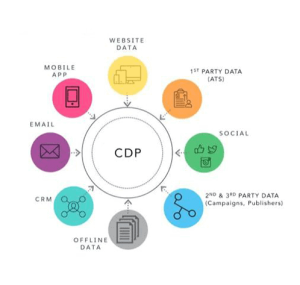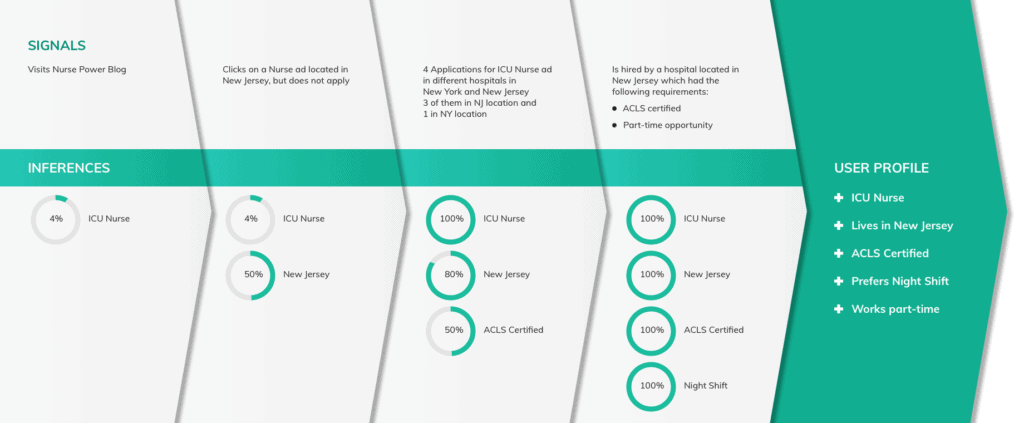While we were attending HR Tech this year, one of our clients asked me – “Jahangir, what can we do to take our advertising to the next level?”
I responded – “Let’s implement CDP.”
The client asked candidly – “What do you mean by CDP?”…and we delved into the details.
This conversation really opened my eyes to the disparity which exists between the need for data-driven job advertising and the awareness around it.
There was a report by ExchangeWire in 2015 where the respondents surveyed cited the largest barrier to implementing data management platforms as a lack of and inability to understand the ROI. According to a recent study by Forrester Consulting TEI in 2019, CDP ROI was around 802% within 12 months and the industry added 19 new vendors.
What is CDP?
CDP (Customer Data Platform) is the gateway to nirvana of job-advertising – “Right candidate, right time, right ad.”
Defined more formally, CDP is a technology that aggregates and organizes data across various touchpoints and channels.
For example, when you are looking to buy a watch online, you would go to different sites to research, read reviews on them, and compare prices on a couple before making the final purchase. The story is the same for a jobseeker today zigzagging between various job-board sites and interacting with different devices before applying for a job.
Add to it, the amount of data generated is also enormous, thanks to the Internet and smartphones. According to Science Daily, ninety percent of all data has been created in the last two years.
Welcome to the big data era and the recruitment industry is no exception to it. Advertisers, Agencies, staffing companies, RPOs and Job-boards – all of them are inundated with data. The data we have in front of us is massive and making sense of it is a huge challenge.
Imagine knowing exactly which jobseekers are looking for a truck driving job in Atlanta and knowing how to reach out to them directly. Imagine knowing who are the right candidates for a software developer job. Imagine knowing the job site which provides the highest quality candidates for Senior Sales Representatives. Imagine being able to re-engage and re-target even passive candidates. Well, this is entirely possible, and let’s see how CDP can do this.
Let’s dive into the numbers, with the latest talent sourcing and recruitment advertising benchmarks!
Ready to Let the Data Do the Talking?
How does it work?

CDP helps the business by primarily focusing on the aspects below:
- Data collection – Collects data from various sources – online, offline and/or contextual data. The data collected could be from different sources like 1st party – directly from the applicant tracking system, mobile apps, websites, publishers, email marketing, and CRM systems.
- Integrations – Integrates data from various sources and applicant tracking systems.
- Personas – Allows you to create different audiences like truck drivers living in Atlanta, or qualified candidates who were rejected 6 months back, etc.
- Analytics – Provides predictive intelligence and discovery of patterns by analyzing historical data.
- Activation – Activate data to drive better candidate experience by personalizing and understanding the candidate journeys better.
So…what’s in it for you?

Marry the candidate to…the job
CDP creates one single unified view of a candidate by mapping all the identities of the user across different touchpoints. The better we know the candidate, the better we can match the right job to the candidate, thus enabling hyper-targeting.
To leverage this data, don’t you think a seamless integration with DSP will make it effective?
DSP with CDP built-in, save $$$
A demand-side platform without a CDP is like a robot without intelligence.
DSP with CDP built-in improves the ROI of campaigns by optimizing the outcomes which truly matters, like hires. The combination forms a virtuous cycle feeding into one another and getting better all the time. Having both of them in one place reduces integration costs.
Activate the passive audience
The US unemployment rate dropped to near a 50-year low of 3.5 percent in September 2019. It’s necessary for employers to attract passive job seekers to remain competitive in this tight labor market.
Also, the employers target passive jobseekers as its also indicative of the candidates being successful at work.
Look-alike modeling
“Jim is a terrific Sales Representative. Are there more people like Jim?” Look-alike modeling helps in finding more candidates like the ones who are successful. This technique helps expand reach smartly without losing the effectiveness of targeting.
Personalization
Imagine a job-board that is able to personalize the content for jobseeker – like Netflix personalizes based on viewing history – even when the jobseeker is not logged in. Imagine having the ability to send a personalized email to the jobseeker.
Today’s jobseeker is used to personalized web journeys from buying things on Amazon, searching for things on Google, and watching movies on Netflix. Similarly, the jobseeker expects relevant job content and less noise.
The Big picture
Predictive Analytics analyze current and historical patterns to help dig things out and prepare for tomorrow. Having all pieces of data in one place makes it easier to ask the system questions of varied nature.
A word of caution
So, it’s quite clear by now that DSP along with CDP is the right way to go. Right now, you may be tempted to look at a few CDP solutions. Although there are some great CDP solutions out there, they are not tailored to recruitment needs.
Here are the top 4 reasons why you should not go with an off-the-shelf CDP:
- Recruitment programmatic solution (DSP): Integrating with existing recruitment programmatic solutions is going to be a huge challenge.
- Integrations: Existing CDPs don’t have extensive integration support with recruitment software solutions and assets like resumes.
- Audiences: Lack of recruitment specific audiences to build and nurture.
- Intelligence: Lack of access to recruitment specific intelligence like similar jobs (job to job match), right candidates for a job (job to candidate match) and look-alike audiences (candidate to candidate match).
History often rhymes. Martech and Adtech started out initially with DSP, added CDP later. Is recruiting tech about to follow suit?
If you want to be at the forefront of innovation and experience the power of a recruitment specific CDP which is integrated with DSP, please reach out directly to me at [email protected].
About Joveo
Joveo® delivers the most relevant hires in the shortest time to companies around the world. Providing real-time insights at every step of the job seeker journey from click to hire, our AI-powered job advertising platform dynamically manages and optimizes sourcing and applications across all online channels. Powering 15M+ job postings every day, our machine learning continuously identifies success, learns and improves to reach the talent you need, when you need it.
Built for ease of use, Joveo replaces the guesswork, complexity, and inefficiency of today’s recruiting with intelligence, transparency and efficiency, delivering more relevant candidates, more certainty, more success.














